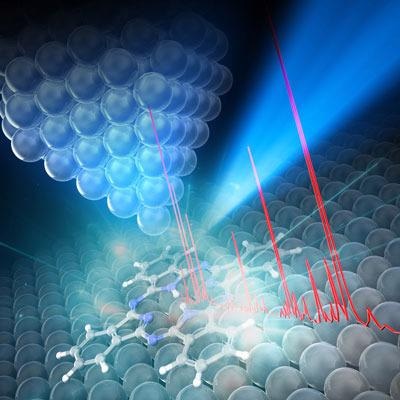Reviewed by Alex SmithNov 22 2021
A new nanospectroscopy technique developed by physicists at RIKEN has enabled them to obtain a spectrum from a single molecule. Such a potential to probe individual molecules will prove indispensable for customizing the properties of organic materials used in such devices as solar cells and light-emitting diodes (LEDs).

By using a tip of a scanning tunneling microscope (inverted pyramid) and the beam of a tunable laser (blue beam), RIKEN physicists have taken a spectrum (red line) from a single molecule lying on a surface. © 2021 RIKEN Surface and Interface Science Laboratory.
When a molecule is excited, either by applying an electric field or through irradiation by light, it can behave in interesting ways. For instance, the excited molecules exhibit the ability to emit light, take part in chemical reactions in which non-excited molecules cannot be a part, or emit electrons upon illumination by light. Several artificial devices and natural systems leverage these abilities of excited molecules.
Light-based spectroscopy techniques are valuable for analyzing excited molecules jointly. However, the inability to focus light beams below a specific width has hampered the application of these techniques to nanoscale samples.
On the other hand, although electron and scanning probe microscopes have the ability to image objects at the atomic level, they do not offer a good deal of spectroscopic information offered by optical techniques. Scientists have been aspiring to combine the benefits of both these approaches.
Hiroshi Imada from the RIKEN Surface and Interface Science Laboratory and his colleagues recently achieved this goal by creating a laser nanospectroscopy method that can obtain a spectrum from a single molecule.
We combined scanning tunneling microscopy with laser spectroscopy to simultaneously achieve high spatial and energy resolutions. That allowed us to reveal the nature of molecules with unprecedented precision.
Hiroshi Imada, RIKEN Surface and Interface Science Laboratory
The researchers exhibited the sensitivity of this technique by working on two molecules that differed very slightly: each of two hydrogen atoms located at the center of one molecule had an additional neutron. The nanospectroscopy technique could help identify this tiny difference in mass between the molecules.
The technique involves using a laser beam to propel a plasmon’s electromagnetic field—electrons in a metal that vibrate in unison—that is formed between the tip of a scanning tunneling microscope and the metal substrate in which the sample is located.
The diameter of the plasmon is only 2 nm—approximately 100 times smaller compared to the narrowest width of a focused laser beam—meaning the spatial resolution of the technique is extremely high.
The researchers used the accurate nanospectroscopy technique to find an innovative way to adjust the energy levels of single molecules through the application of a static electric field.
The resonance energy of a single molecule can be tuned by applying a voltage. This mechanism, which hadn’t been visualized previously, emerged unexpectedly as a result of symmetry breaking at the molecular level.
Hiroshi Imada, RIKEN Surface and Interface Science Laboratory
Now, the researchers intend to devise a time-resolved version of this nanospectroscopy technique.
We plan to develop ultrafast nanospectroscopy to shed light on energy conversion in molecular systems.
Hiroshi Imada, RIKEN Surface and Interface Science Laboratory
Journal Reference:
Imada, H., et al. (2021) Single-molecule laser nanospectroscopy with micro–electron volt energy resolution. Science. doi.org/10.1126/science.abg8790.